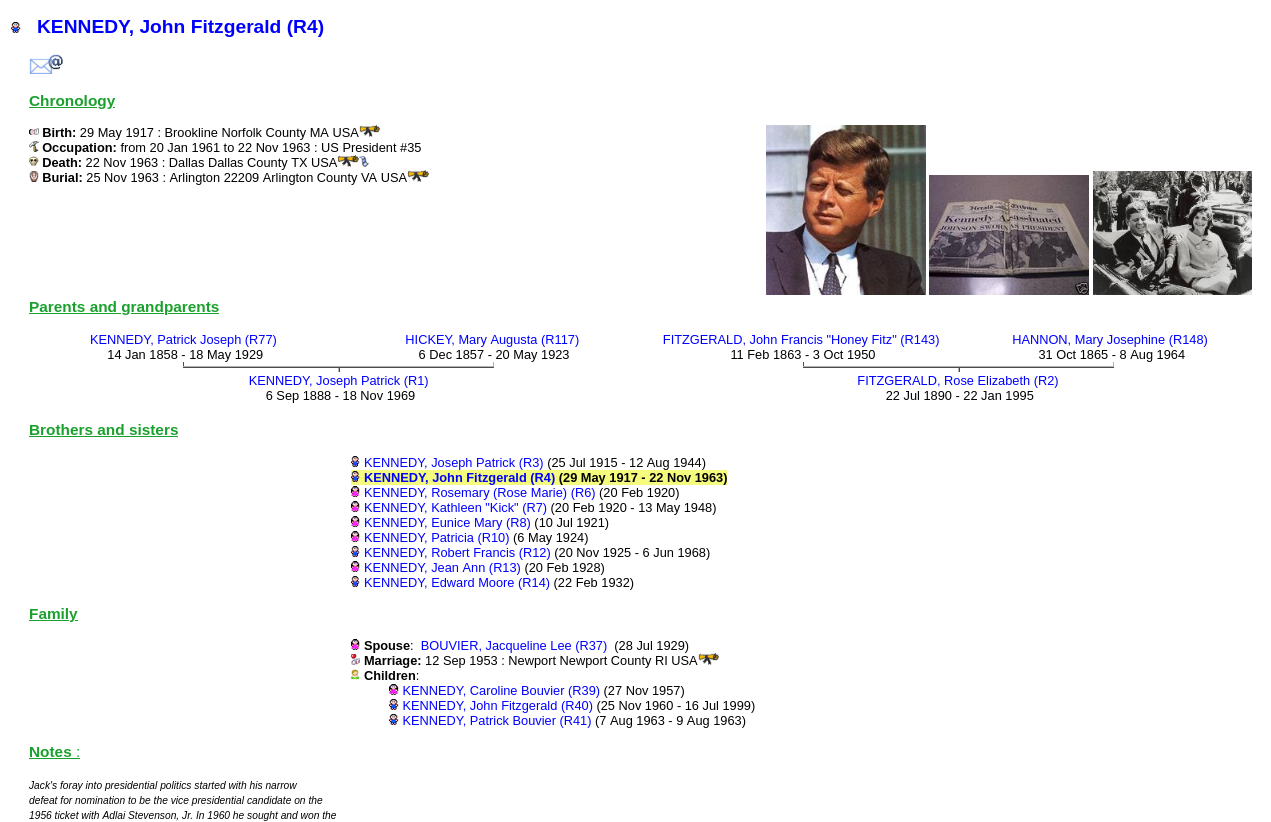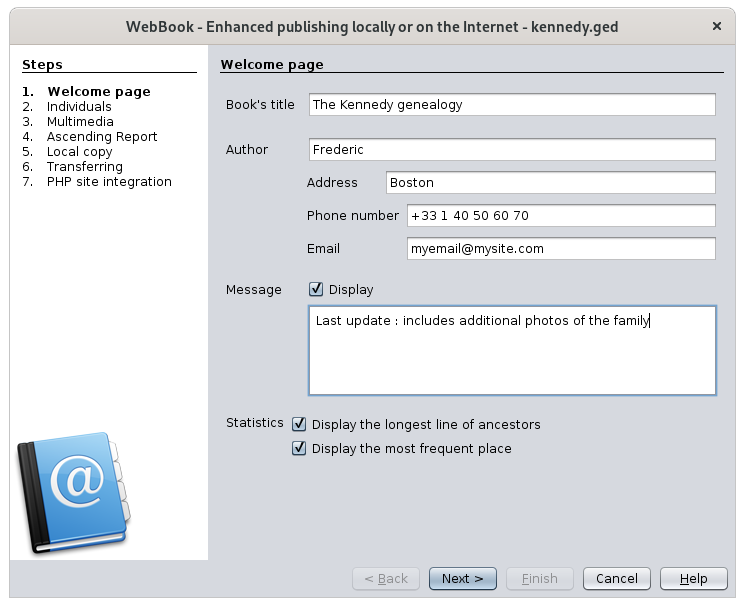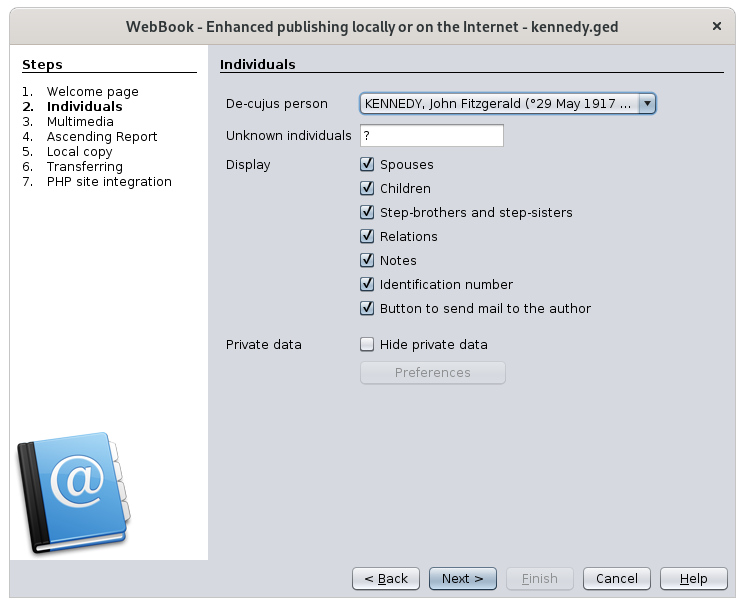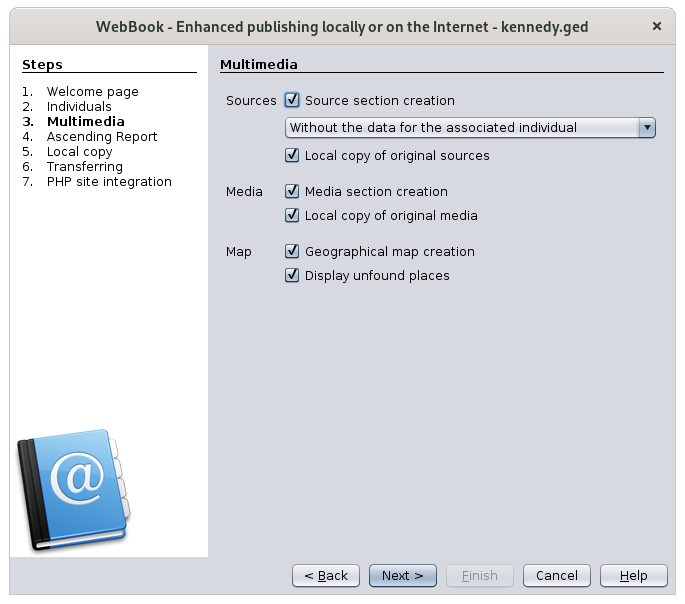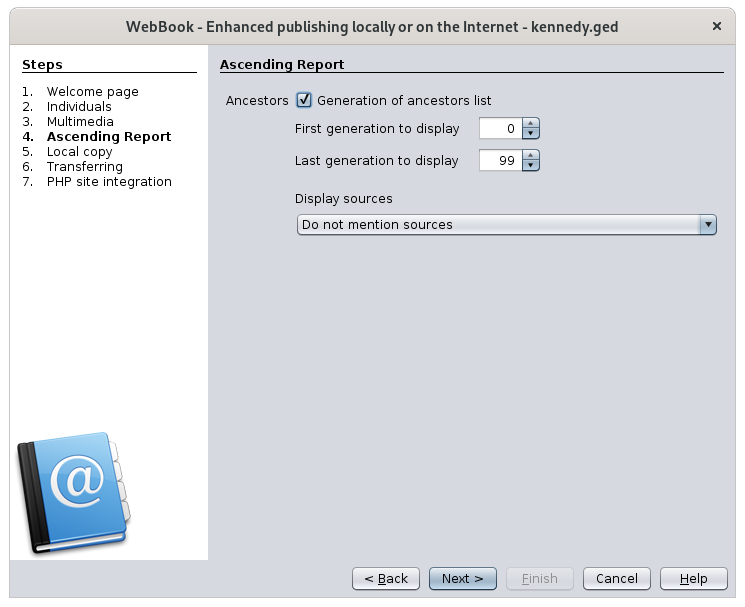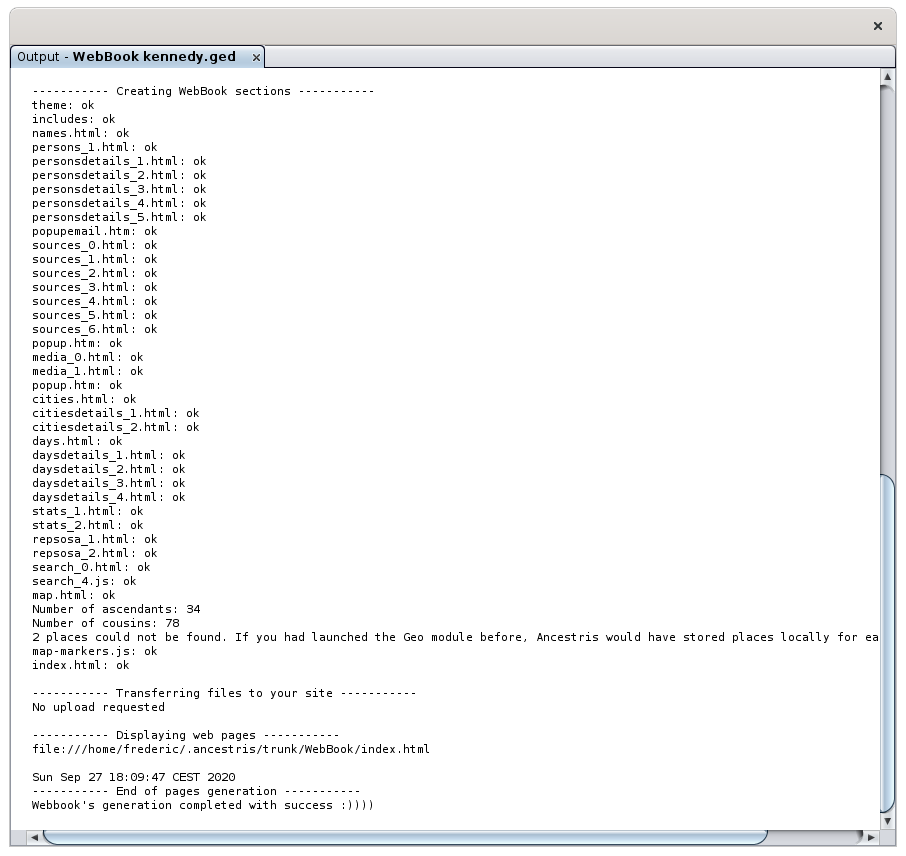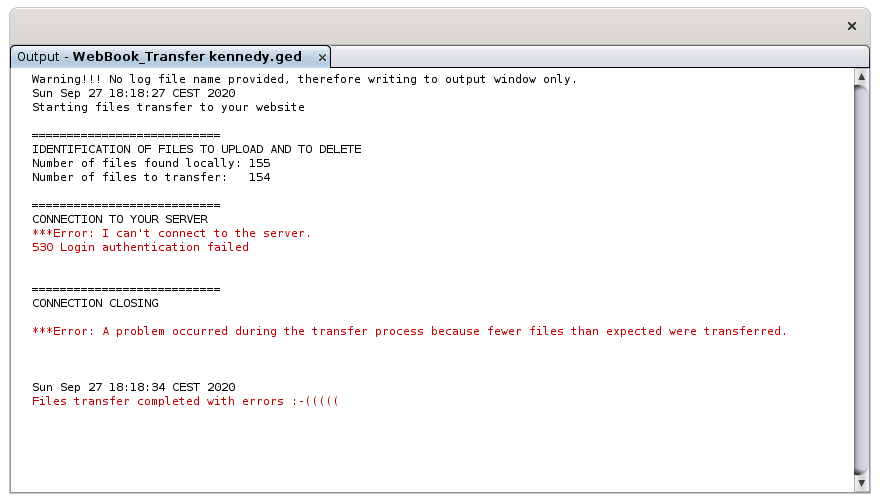WebBook (L)
The Web bookWebBook makes it possible to generate Web pages, from a genealogy file to be placed locally, on a private usb key to share with relatives, or on a public Internet site.
Comment from a user:
This little book is really convenient, pleasant to use and complete enough to go through one's genealogy.
I may not know how to use other genealogy software correctly, but when I made an web export with them, I found the result harsh and less intuitive.
If you do not want to put your genealogy tree and data on a web site, no problem, you can just make a local copy on any support (hard disk, USB key...) and consult it with any internet browser.
Description
The previous image is an example of the Web Book with the Kennedy family tree.
An extract of the Individuals details pages looks like this:
The WebBook works with the Map View if you want to generate a map.
Navigation in the generated pages
The pages generated constitute the sections of a "web book". Many sections are accessible from the home page and part of the content can be customized.
Lastnames: This section lists the surnames and their frequency of appearance in the family tree.
Individuals list: This section lists all the individuals in the tree in alphabetical order.
Individuals details: This section gives a detailed description of all the individuals. For each individual, there are details about birth, marriage and other events. Details also include grandparents, parents, half-brothers and half-sisters, marriages, children, relationships (godparents, godmother, witnesses, etc.), and notes. This section also displays up to five photos or media related to each individual or their marriage(s). For each event a source icon allows you to see if a source exists. Simply click on the icon to see it. The images and media of the sources are not displayed in this section but in the sources section.
Sources: The first page of this section displays the list of all the sources of the genealogy. The following pages give the details of each source. The source details include, where available, the text of the source and the images and media of the source and associated individuals and families. If the media is not an image then the document is considered to be of a different nature and an image representing a media file is displayed. Clicking on the image brings up the source document in its original size or launches the media (sound, video, etc).
Photos and other media: The first page of this section displays a list of all the media in the genealogy that are associated with individuals and families. The following pages give the images of these media in the form of a photo album. This section does not contain the source material. If the media is not an image then the document is considered to be of another nature and an image representing a multimedia file is displayed. Clicking on the image brings up the source document in its original size or launches the media (sound, video, etc). If the media is not found, an image indicates this, allowing you to rectify your genealogy if necessary.
Geo map: This section displays a geographic map with the location of all the cities identified in the family tree. This map is interactive and you can zoom in, show ancestors or cousins, birth, marriage or death, or events between two given years. By clicking on a city, you will see the main information about the events that took place there. These maps only work if the coordinates of the locations exist and are correct. For this, it is recommended to check the Geographic map view.
Cities list: This section gives the list of cities where at least one event in the family tree took place.
Cities details: This section details for each location all the events that took place there. If you have generated the map, a small icon may show you the location of the city on the map.
Family Calendar: This section lists the days of the year when at least one event in the family tree took place.
Calendar Details: This section details for each day of the year all the events that took place there.
Statistics: This section presents the frequency of surnames, places and days of the year, from the most to the least frequent.
Inbreeding degree: This section presents the inbreeding ratio of the selected main individual.
Ancestors List: This section presents the ancestors of the selected main individual. The ancestors are displayed in ascending order of Sosa number.
Individuals search: This section is a tool to search for individuals in your family tree using a set of criteria.
Web book generation wizard
The wizard assists you to customize the pages of the Web book through 7 panels. At the end, it shows you the log of the generation.
Welcome page
This panel customizes the Welcome page of your family tree book.
Hovering over a field displays a tooltip explaining its role.
- Book's title: title of your Genealogy book. It appears on the home page and in the title bar of the browser.
- Author: name of the author of your Genealogy.
- Address: address of the author.
- Phone number & Email: contact information of the author.
- Message: check the box and write a message to display it at the beginning of the home page.
- Display the longest line of ancestors: display information about the longest ancestor line in your Genealogy.
- Display the most frequent place: display this statistic on the home page.
Individuals
-
De-cujus person: main individual who will be accessible from the home page, and from whom the longest line of ancestors and the ancestor report will be built.
-
Unknown individuals: This is used to designate a person whose first and last names are unknown (example: you can put the word "unknown" in this field).
DisplayDisplay: information to display in the individuals details sections
-
Spouses:
if you want todisplaythespousesspouses.information -
Children:
Selectdisplaythischildrenoption if you want to displayunderneath thechildrenfamilyin the families.information -
Step-brothers and step-sisters:
Select this option if you want todisplayhalf-step-brothers andhalf-step-sisters. These are referred toin the Descendants,asuterin/uterin or consanguineous siblings. -
Relations:
Select this option if you wish todisplay the relationshipsthatoflinktheindividuals togetherindividual (i.e.events'whether a person has been a witness at a wedding for example,witnesses, godparents, etc.). -
Notes :
Select this option if you wish to viewadd the notes associated with individuals and families. -
Identification numbers:
Select this option if you wantadds Ancestris ID numbersto be addedafter the person's name. -
Button to send mail to the author:
Select this option if you want todisplay a "send email" icon at each individual section so that theuservisitor can easily send an email to the author aboutanthis individual.
-
- Private data:
- Hide private data:
xxxhides data defined in the privacy preferences. - Preferences:
xxxtakes
- Hide private data:
You can then chooseyou to hidethe privacy preferences to change them if necessary for the privateWeb data and redefine it using the Preferences button. This button will open the Ancestris preferences window.
On a PHP site, private data will be generated but hidden
profile php function will have to exist in the site.and visible only by using; apassword.On an html
at allsitesite,thatdata isstatic,static and private informationiswill not be generated
Multimedia to display
Sources
- Sources
- Source section
generation:creation:Selectaddthisaoptionsectionifto access sources. - Drop-down menu: choose how you want sources to
generatebe displayed : with the individual information only, with the text of the sourcesection.and with the media. Display source images: Use this drop-down menu if you want to display the documents related to the sources. You can display or not the source links of the associated entities, with a simple text link or a thumbnail image reminding the source.- Local copy of
originals:originalSelect this option if you want tosources: copy the original documents to yourwebsite.destination directory (local or website). Otherwise,linkfilefileslinks are used. It is recommended not to select this option if the total size of your documents is large. If you later want to have these documents on your website, you can always replace the link files with smaller size files using the copy function of your system.
- Source section
- Media
GenerateMediaPhotosectionSection:creation:Selectaddthisaoption if you wantsection togenerateaccessthe media section.media.- Local copy of
originals:originalSelect this option if you want tomedia: copy the originaldocumentsmedia files to yourwebsite.destination directory (local or website).
Otherwise, link files are used. This option is similar to the source option described above.
- Map
MapGeographicalgeneration:mapSelectcreation:thisaddoptionaif you wantsection togeneratedisplaytheofinteractivemapmap.of events.- Display
ofunfound placesnot found: Select this option if you want to: display markers for cities whose coordinates were not found. Markers will appear in the middle of the Atlantic Ocean
AdditionAscending of the ascending reportReport
GenerateGenerationAncestorofList:ancestorsSelectlist:this option if you want to generateadd the ancestorlist.report using the De-cujus individual as the root. In this case you will be asked for the following options when generating this section- First generation to display
Ancestorsgeneration number from which the ancestors list willonly be displayed from the indicated generation on.start. - Latest generation to display
Ancestorsgeneration number to which the ancestors list willonly be displayed until the indicated generation.stop. - Display
sources:sources:Choosechoose if and how to displaythesourcessources. Usein themenuancestorstoreport.
Local publishingcopy
LocalSaveWebWebBookBooklocally:Backup: Specifyspecify the directory where theWeb BookWebBook will be located on your disk. It is this directory that you will consult locally with an internet browser(Firefox for example) or a file manager with a browser (Konqueror for example)if you do not wantto tracehave your genealogy onyourthewebsite.Internet. If you want to upload it onto an Internet web site, the content of this directory will be uploaded. This is an option on the next panel.
Watch out! This directory must be empty, otherwise the documents it contains will be deleted.
SavingSavetheWebBookgenerationtransfer logoffile:the book: Indicateindicate the directory where thegenerationWebBook creation log report will belocatedlocated.whichItcontainswill contain thescrollstep-by-step creation and possible errors.
Possible transfer over the InternetTransferring - optional
If you only want to generate the pages locally, uncheck the first check box and simply click next.Next.
MoveUploadupweb pages on web site: uploads the pagesonthattheweresite:savedSelect this option if you want to move up the pageslocally on a website of your choice. You will need to provide additional information to enablesuchthea page lift.upload. These are the following options. If you choose tobring upupload the pages on a website, the report will ask you to fill in the name of a log file. This file will contain a complete list of the uploaded files.- Website FTP
address:address:Addressaddress of your FTP site. Ex: ftp.nom2monsite.monfournisseur.frmysite.myinternetprovider.com - Root directory
for your pages on the site: This is the: target directory where the pages must be uploaded. ex: /directory/home/ - FTP user
name:name:the name to be used for access to the FTP site, it is the name that identifies you on the site. Passwordlogin to be used to access the FTPsite:site.- FTP
is thepassword: password to access the FTP site. DescriptionSiteofdescription: thewebsite : Thesentence you will put here will appear in the headers of the html pages created as "meta name - Description". This element is important, because robots, search engines, willexamineusethesethispartstoofindex yourfiles.pages.TypeTransferof transfer: This optiontype: allows you to improve theefficiencyuploadof the pages on your site.time. For example, if a photo of an ancestor is generated in theWeb BookWebBook but it is identical to the one previously uploaded, there is no need to upload it again.- Program to launch
atafterthe end of the Web Book generation: Specify here thegeneration: name ofthea executable program to launch at the end of theWebWebBookBook generation.creation. If the first character is '0' then this option is ignored. Launching a program at the end can be useful if there are still other things to do on your site to finalize its update. BackupSaveoftransferthelogupload log: Specify here thefile: directory where the upload logshouldreport will be saved. This log report showsyouthedetailsresults of the uploaded pages.
Possible integration to a PHP site integration - optional
If you only want to generate the pages locally, uncheck the first check box and simply click next.Finish.
This part is technical and requires to know the principles of a PHP site including very precise page structures.
- PHP
site: Check this boxsite: if you want to leverage the fact that your site is written in PHP ProfileCodes:Codesusername andCode are the usernames and passwordspassword used to view private information.- Existing site
Checkcheck this box if thegenealogicalgenealogy pages are integrated in a larger site, and must then respect the same headers and footers for example - Private
data:data: Indicate here the name of the PHP function that will test the codes for private data. Scripts:Scripts: Indicate here the PHP scripts corresponding to the different components of your PHP website
Result of the generation
Ancestris displays the Output windows at the end of generation, where you can see each of the two logs: generation and transfer if applicable.
Here you have an example of generation that went well.
Result of the transfer
Here you have an example of a transfer that went wrong.
Additional information
- Private information is managed using the Ancestris options. If an individual is considered private according to the Ancestris options, the web book will display "..." instead of the plain text details.
- The Sosa numbering is taken into account if the labels "_SOSA" are present in the gedcom file. This label can be generated using the "Toolbox" report. Be sure to run both reports (Toolbox and Web book) with the same "first" individual.
- If the local directory in which the pages will be generated is not empty, a message tells you so. This message appears in the Ancestris window for running the report.
The generated html pages are W3C XHTML 1.0 certified. - Special characters are replaced in the pages by the equivalent html sequence (example: "é" is replaced by "é")
- In order to optimize performance, media and source files are not copied (or linked) if they already exist in the target directory. To force this copy (or these links), just delete the files in the target directory.
- A feature makes it easy for the website user to send email to the author
- An intelligent page rollup feature saves a considerable amount of time by only rolling up files whose content has changed. This works very well as long as the WebBook is the program used to pull up the pages because it keeps the details of the files transferred each time.


